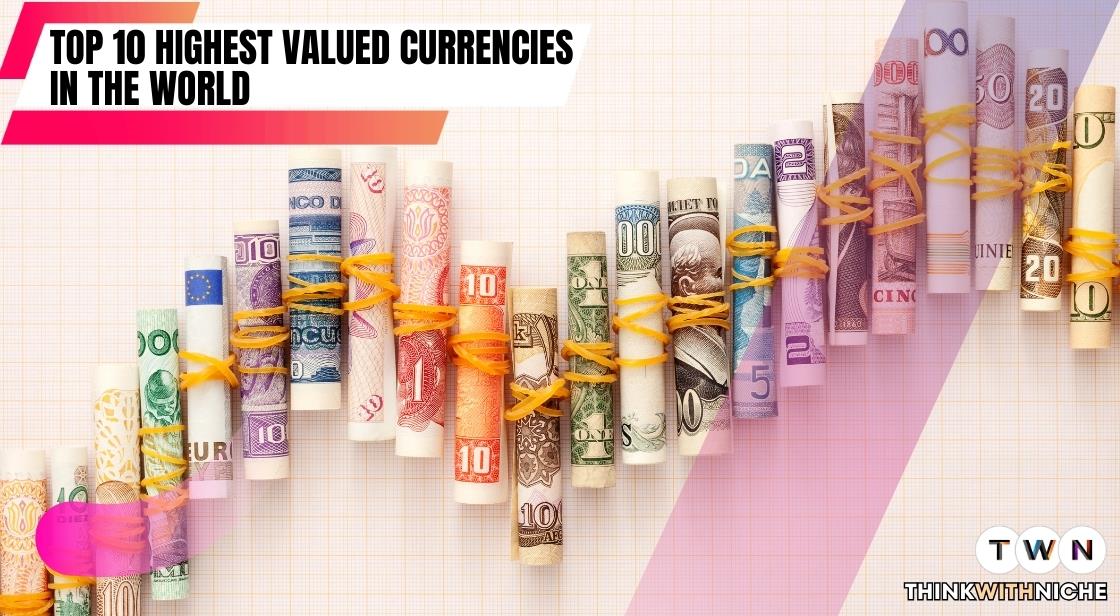Top Highest Valued Currencies in the World

Blog Post
Currency valuation plays a pivotal role in the global economy, reflecting a country's economic strength, stability, and influence in international trade and finance. Among the multitude of currencies circulating worldwide, some stand out for their exceptionally high value relative to others.
These currencies, often backed by robust economies and stable political systems, command significant respect and recognition in the global financial landscape. Understanding the top highest valued currencies offers insights into the economic powerhouses driving global commerce and investment.
At the pinnacle of this hierarchy sits currencies that not only retain their domestic purchasing power but also wield substantial influence in international markets.
The criteria for determining currency value encompass various factors, including GDP, inflation rates, interest rates, political stability, and foreign exchange reserves. Countries with strong economic fundamentals and prudent fiscal policies tend to have currencies that rank higher in value.
From the stalwart US dollar, the world's primary reserve currency, to the Swiss franc renowned for its stability, each of the top highest valued currencies holds a unique position in the global financial system.
These currencies serve as benchmarks for international transactions, investments, and reserve holdings by central banks worldwide. Moreover, their strength often reflects broader economic trends and geopolitical dynamics shaping the interconnectedness of nations on a global scale.
In this exploration of the top highest valued currencies, we delve into the factors underpinning their strength and examine the implications of their prominence in the ever-evolving landscape of international finance.
Top-Ranked Currencies: Highest Values Globally
1. Kuwaiti Dinar (KWD)
Crown prince of Kuwait -
Mishal Al-Ahmad Al-Jaber Al-Sabah
Kuwait 2023 GDP:
Kuwait’s GDP reached $175.36 billion in U.S. dollars in 2023
The Kuwaiti dinar's strength is a result of Kuwait's significant oil wealth, strategic positioning, and effective economic management, making it the strongest currency in the world.
Currency Introduction of Kuwaiti:
-
The Kuwaiti dinar was introduced in the 1960s as the official currency of Kuwait.
-
Initially, it was pegged to the British pound, reflecting historical ties with the United Kingdom.
Currency Strength of Kuwaiti:
-
The Kuwaiti dinar (KWD) holds the title of the strongest currency globally, with 1 Kuwaiti dinar equivalent to 3.25 U.S. dollars.
Oil Wealth of Kuwaiti:
-
Kuwait, situated between Saudi Arabia and Iraq, is a major player in the global oil industry.
-
The country earns substantial wealth from its status as a leading exporter of oil, contributing significantly to its economic strength.
Pegging Mechanism:
-
Over time, the Kuwaiti dinar underwent changes in its pegging mechanism.
-
It was re-pegged to an undisclosed basket of currencies, allowing for stability and flexibility in its exchange rate.
Economic Impact of Kuwaiti dinar:
-
The strength of the Kuwaiti dinar underscores the economic prosperity and stability of Kuwait as a nation.
-
It reflects the country's ability to maintain robust fiscal policies and manage its natural resource wealth effectively.
Global Recognition:
-
The recognition of the Kuwaiti dinar as the strongest currency serves as a testament to Kuwait's economic prowess on the international stage.
-
It instills confidence among investors and traders in Kuwait's economy and financial system.
Strategic Positioning:
-
Kuwait's strategic location and its role as a key oil exporter contribute to the stability and strength of its currency.
-
The country's prudent economic management further solidifies its position as a global financial hub.
Continued Influence:
-
Despite fluctuations in global economic conditions, the Kuwaiti dinar maintains its status as the strongest currency, reflecting resilience and confidence in Kuwait's economy.
2. Bahraini Dinar (BHD)
king of bahrain -
Hamad bin Isa Al Khalifa
Bahraini 2023 GDP:
GDP reached BD 13,661.22 million at constant prices during 2023
The Bahraini dinar's status as the second strongest currency in the world reflects Bahrain's economic resilience, driven by its oil and gas sector, strategic location, and commitment to monetary stability.
Currency History of Bahraini:
-
The Bahraini dinar was introduced into circulation in 1965.
-
Since its inception, it has been pegged to the U.S. dollar, maintaining a fixed exchange rate that enhances its stability and reliability in global trade.
Strength and Ranking of Bahraini:
-
The Bahraini dinar holds the position of the second strongest currency in the world.
-
With 1 Bahraini dinar equating to 2.65 U.S. dollars, it boasts considerable value in international exchange markets.
Economic Background of Bahraini:
-
Bahrain is an island nation situated in the Persian Gulf, adjacent to Saudi Arabia.
-
Similar to Kuwait, Bahrain derives a significant portion of its wealth from oil and gas exports, contributing to its economic stability and currency strength.
Oil and Gas Sector of Bahraini:
-
The oil and gas industry plays a pivotal role in Bahrain's economy, driving economic growth and bolstering the nation's financial resources.
-
Revenue generated from oil and gas exports contributes substantially to Bahrain's GDP, fostering economic prosperity and currency stability.
Pegging to the U.S. Dollar:
-
The decision to peg the Bahraini dinar to the U.S. dollar provides a foundation of confidence for investors and traders.
-
This pegging arrangement instills trust in the Bahraini currency, facilitating smooth transactions and promoting economic growth.
Regional Influence:
-
Situated in a geopolitically strategic location within the Persian Gulf region, Bahrain serves as a vital hub for trade and commerce.
-
Its stable currency, coupled with a thriving economy, positions Bahrain as an influential player in the global financial landscape.
Continued Stability:
-
Despite fluctuations in global markets, the Bahraini dinar has maintained its strength and stability over the years.
-
This resilience underscores Bahrain's commitment to sound economic policies and prudent fiscal management.
Investment Opportunities:
-
The strength of the Bahraini dinar and the stability of the nation's economy create favorable conditions for investment.
-
Investors seeking opportunities in the Middle East region often consider Bahrain as a promising destination due to its robust currency and conducive business environment.
Also Read: A Look At The Most Expensive Cars In The World – Who Owns Them?
3. Omani Rial (OMR)
king of oman-
Haitham bin Tariq Al Said
GDP of Oman 2023:
GDP of Oman 38.2 billion OMR by the end of 2023.
Introduction of the Omani Rial:
-
The Omani rial was introduced in the 1970s, marking a significant milestone in the country's economic development.
-
Its introduction coincided with Oman's emergence as a major player in the global energy market.
Currency Strength of Oman:
-
The Omani rial ranks as the third strongest currency globally, with 1 Omani rial equivalent to 2.60 U.S. dollars.
Geographical Context:
-
Oman is situated between the United Arab Emirates and Yemen, positioned at the tip of the Arabian peninsula.
-
Like its affluent neighbors, Oman is a significant exporter of oil and gas, contributing to its economic prosperity.
Pegging to the U.S. Dollar:
-
The Omani rial is pegged to the U.S. dollar, ensuring stability and reliability in its valuation.
-
This pegging mechanism provides confidence to investors and facilitates international trade and transactions.
Economic Significance:
-
Oman's reliance on oil and gas exports has been instrumental in bolstering the value of its currency.
-
The stability of the Omani rial reflects the country's robust economic fundamentals and prudent monetary policies.
Regional Dynamics:
-
Positioned amidst affluent Gulf Cooperation Council (GCC) nations, Oman benefits from a favorable regional economic environment.
-
The collective economic strength of the region contributes to the stability and prominence of the Omani rial.
Global Recognition:
-
The strength of the Omani rial underscores Oman's standing in the international financial arena.
-
Investors and traders recognize the value and stability offered by the Omani currency, further enhancing its global reputation.
Continued Resilience:
-
Despite fluctuations in global economic conditions, the Omani rial has demonstrated resilience and maintained its position as one of the world's strongest currencies.
-
This resilience reflects Oman's commitment to economic diversification and sustainable development strategies.
4. Jordanian Dinar (JOD)
The king of Jordan -
Abdullah II
GDP of Jordanian
Jordan's GDP was $110 billion at the end of 2023
Introduction of the Jordanian dinar:
The Jordanian dinar has been in circulation since 1950. Its stability is partly attributed to its peg to the U.S. dollar, which helps in maintaining a relatively steady exchange rate.
Currency Strength of Jordanian:
The Jordanian dinar is recognized as the fourth strongest currency globally, with 1 Jordanian dinar equivalent to 1.41 U.S. dollars.
Economic Context:
Jordan, a predominantly land-locked country, shares borders with Egypt, Syria, Iraq, and Saudi Arabia. Despite its strategic location, Jordan faces challenges such as sluggish economic growth and mounting debt.
Economic Diversity:
Unlike some of its neighboring countries, Jordan has a lesser reliance on oil and gas exports, contributing to its economic diversity. However, this diversity doesn't shield it entirely from economic challenges.
Peg to the U.S. Dollar:
The peg to the U.S. dollar provides stability and confidence in the Jordanian dinar. This pegging ensures that fluctuations in the value of the U.S. dollar directly influence the value of the Jordanian dinar.
Economic Challenges:
Despite its strong currency, Jordan grapples with economic hurdles such as sluggish growth and rising debt. These challenges highlight the complexities of maintaining economic stability in a volatile global market.
Geopolitical Significance:
Jordan's geopolitical position as a bridge between multiple countries adds to its economic significance. However, this also exposes it to various political and security risks that can impact its economic stability.
Ongoing Efforts:
Despite economic challenges, Jordan continues to implement measures to stimulate growth and address debt concerns. These efforts underscore the government's commitment to ensuring economic resilience and stability.
5. British Pound (GBP)
Prime Minister of United Kingdom -
Rishi Sunak
GDP of British
Gross domestic product of the United Kingdom in 2023 was 2.274 trillion British pounds
Introduction of the pound:
-
The pound sterling has a rich history, dating back to its introduction in the 1400s.
-
It underwent decimalization in 1971, transitioning to a system based on multiples of 10.
Currency Strength of British pound:
-
The British pound (GBP) ranks as the fifth strongest currency globally, with 1 British pound equating to 1.26 U.S. dollars.
Economic Significance:
-
Britain stands as the sixth largest country by gross domestic product (GDP) based on data from the World Bank.
Free-Floating Currency:
-
The pound operates as a free-floating currency, meaning its value is determined by supply and demand dynamics in the foreign exchange market.
-
Unlike pegged currencies, it is not tied to a fixed exchange rate against other currencies.
Global Trade and Investment:
-
The strength of the pound facilitates international trade and investment, providing stability and confidence to businesses and investors dealing with British assets.
Impact of Brexit:
-
The decision by the United Kingdom to leave the European Union, commonly referred to as Brexit, has had notable effects on the pound's value and volatility in recent years.
Role in Financial Markets:
-
The British pound plays a significant role in global financial markets, serving as a key currency for foreign exchange transactions and a benchmark for various financial instruments.
Government Policies and Monetary Authority:
-
The value of the pound is influenced by a range of factors, including economic indicators, fiscal policies, and decisions made by the Bank of England, the UK's central bank.
Investor Sentiment and Market Perception:
-
Investor sentiment towards the UK economy, geopolitical stability, and global economic conditions also impact the performance of the pound in currency markets.
Future Outlook:
-
The trajectory of the British pound's value will continue to be shaped by domestic economic developments, international trade relations, and broader market trends in the years ahead.
6. Cayman Islands Dollar (KYD)
Premier of the Cayman Islands-
Julianna O'Connor-Connolly
GDP of Cayman Islands Dolla
gross domestic product of the Cayman Islands in 2023 was $6.99 billion
Introduction and Pegging of Cayman Islands:
-
Introduced in the 1970s, the Cayman Islands dollar has been the official currency of the British territory.
-
It operates as an offshore financial center, contributing to its stability and prominence.
-
The currency is pegged to the U.S. dollar, ensuring stability and facilitating international transactions.
Cayman Islands Dollar (KYD) Strength
-
The Cayman Islands dollar ranks as the joint sixth strongest currency globally.
-
It boasts a strong exchange rate of 1 Cayman Islands dollar purchasing 1.20 U.S. dollars, reflecting its robust value.
Cayman Islands Economy:
-
The Cayman Islands, located in the Caribbean, serve as a significant financial hub.
-
Its economy relies heavily on banking, investment funds, and tourism.
-
As an offshore financial center, it attracts international businesses and investors, contributing to its economic strength.
Relationship with the U.S. Dollar:
-
The Cayman Islands dollar's peg to the U.S. dollar is crucial for its economic stability.
-
This peg ensures consistency and predictability in exchange rates, facilitating trade and investment activities.
Global Recognition:
-
Despite being a small territory, the Cayman Islands and its currency have gained global recognition for their financial services industry.
-
The Cayman Islands dollar's strength and stability enhance its credibility and attractiveness to investors worldwide.
Also Read: 50 Most Popular Women In The Entire World
7. Gibraltar Pound (GIP)
Chief minister of Gibraltar-
Introduction of Gibraltar Pound:
The Gibraltar pound was initially introduced in the 1920s to facilitate economic transactions within the territory.
The relationship between Gibraltar and the United Kingdom has influenced the adoption and pegging of the Gibraltar pound to the British pound.
Currency Strength of Gibraltar Pound:
The Gibraltar pound ranks as the joint seventh strongest currency globally, with a valuation of 1 Gibraltar pound purchasing 1.26 U.S. dollars.
Location and Sovereignty:
Gibraltar is situated at the southernmost tip of Spain and is officially recognized as a British Overseas Territory.
Pegged to British Pound:
The Gibraltar pound is pegged to the British pound (GBP) at par, meaning that the exchange rate is one-to-one. This pegging ensures stability and predictability in currency value.
Economic Significance:
The Gibraltar pound plays a vital role in the economy of Gibraltar, facilitating trade, commerce, and financial transactions within the territory.
Currency Exchange:
While the Gibraltar pound maintains a fixed exchange rate with the British pound, its value against other currencies, such as the U.S. dollar, fluctuates based on global market dynamics.
International Recognition:
Despite being a relatively small currency in terms of global trade volume, the Gibraltar pound's stability and strength contribute to its recognition and acceptance in international financial markets.
Impact of Pegging:
The pegging of the Gibraltar pound to the British pound provides stability and confidence to businesses, investors, and residents in Gibraltar, ensuring a reliable medium of exchange for economic activities.
Continued Use:
The Gibraltar pound remains an integral part of Gibraltar's financial system, serving as the primary unit of currency for daily transactions, savings, and investments within the territory.
8. Swiss Franc (CHF)
President of the Swiss-
GDP of Switzerland
GDP in Switzerland amounted to around 885.14 billion U.S. dollars.
Introduction of Swiss franc:
-
The Swiss franc was introduced in 1850, reflecting Switzerland's longstanding monetary history.
Strength in Global Currency Rankings of Swiss franc:
-
The Swiss franc ranks as the joint eighth strongest currency globally, with 1 Swiss franc equivalent to 1.11 U.S. dollars.
Official Legal Tender:
-
The Swiss franc serves as the official legal tender in both Switzerland and Liechtenstein.
Safe Haven Status:
-
Switzerland's political stability has positioned the Swiss franc as a safe haven currency in times of economic uncertainty.
Pegging and Free-Float:
-
The currency experienced a brief period of being pegged to the euro before transitioning to a free-floating exchange rate system.
Economic Significance:
-
The Swiss franc plays a crucial role in the global financial market, with its stability and strength attracting investors seeking refuge during turbulent economic times.
Currency Symbol of Swiss fran:
-
The symbol for the Swiss franc is "CHF," representing its official abbreviation in international currency markets.
Cross-Border Usage:
-
Due to Switzerland's economic ties and international business relations, the Swiss franc is widely accepted and used in cross-border transactions and investments.
Foreign Exchange Reserves:
-
Central banks and investors often hold Swiss francs as part of their foreign exchange reserves, further highlighting its importance in the global currency landscape.
Role in Monetary Policy:
-
The Swiss National Bank (SNB) governs the Swiss franc's monetary policy, aiming to maintain price stability and support the overall economic health of Switzerland.
Market Dynamics:
-
Factors such as interest rate differentials, economic indicators, and geopolitical events influence the Swiss franc's value in the global currency market.
Continued Relevance:
-
Despite the challenges posed by economic fluctuations and global uncertainties, the Swiss franc remains a prominent and sought-after currency, symbolizing stability and trust in the international financial community.
9. Euro (EUR)
President of the European-
GDP of Euro
GDP in Euro amounted to around $27.36 trillion, U.S. dollars.
Introduction and Circulation of Euro currency:
-
The physical euro currency was introduced in 2002, replacing national currencies like the Deutsche Mark, French Franc, and Italian Lira.
-
Since its inception, the euro has become one of the most widely circulated and accepted currencies worldwide.
Strength in the Global Currency Landscape:
-
The euro ranks as the joint ninth strongest currency globally, with 1 euro equating to 1.08 U.S. dollars.
-
Its valuation reflects its significance as a major currency in international trade and finance.
Official Currency of the Eurozone:
-
The euro serves as the official currency of the Eurozone, comprising 19 out of the 27 countries within the European Union.
-
These countries have adopted the euro as their sole legal tender, facilitating seamless economic integration and trade within the region.
Free-Floating Currency:
-
The euro operates as a free-floating currency, meaning its value is determined by supply and demand dynamics in the foreign exchange market.
-
This flexibility allows the euro's exchange rate to fluctuate based on various economic factors and market conditions.
Economic Significance:
-
The stability and strength of the euro play a crucial role in shaping global financial markets and investor sentiment.
-
As a key reserve currency, the euro is widely held by central banks and financial institutions around the world.
Challenges and Opportunities:
-
Despite its strength, the euro faces challenges such as economic disparities among Eurozone member states and political uncertainties within the European Union.
-
However, ongoing efforts to strengthen economic governance and promote fiscal integration present opportunities for the euro's continued resilience and growth.
Future Outlook:
-
The euro's role in the global economy is expected to evolve further as the Eurozone navigates through economic reforms and geopolitical shifts.
-
Its stability and importance in international finance make the euro a currency to watch for investors and policymakers alike.
10. US Dollar (USD)
The President of US-
GDP of US
U.S. GDP increased from the previous year to about 27.36 trillion U.S. dollars.
Introduction of US dollar currencies:
-
Created in the 1700s, the US dollar serves as legal tender in the United States, its territories, and several sovereign nations such as Puerto Rico, Ecuador, and Zimbabwe.
Strength and Value of US dollar:
-
The US dollar ranks as the 10th strongest currency globally, maintaining a value of 1 against itself.
-
It surpasses all other currencies in terms of value, with each unit worth less than a US dollar.
Global Dominance:
-
The United States boasts the world's largest economy by GDP, contributing to the US dollar's prominent status.
-
It is the most-traded currency internationally, facilitating global financial transactions.
Reserve Currency Status:
-
The US dollar holds the position of the largest reserve currency globally, meaning it is the currency most held by central banks worldwide.
-
Central banks often hold reserves of US dollars to stabilize their own currencies and ensure liquidity in international markets.
Commodity Pricing:
-
The US dollar is commonly used to price various commodities, including oil, gold, and copper.
-
Its widespread use in commodity pricing contributes to its influence on global markets and trade dynamics.
Financial Market Impact:
-
Fluctuations in the value of the US dollar can have significant ramifications across financial markets worldwide.
-
Investors closely monitor US dollar movements as they can signal shifts in global economic conditions and investor sentiment.
Trade and Investment:
-
The prominence of the US dollar in international trade and investment underscores its role as a key facilitator of global commerce.
-
Many international transactions, contracts, and investments are denominated in US dollars, further solidifying its importance in the global economy.
Geopolitical Influence:
-
The US dollar's status as a dominant global currency also reflects the geopolitical influence of the United States.
-
Economic policies and decisions made by US authorities can impact the value and stability of the US dollar, reverberating across the international financial system.
Continued Significance:
-
Despite occasional challenges and debates surrounding its role, the US dollar remains a cornerstone of the global financial system and is likely to maintain its significance for the foreseeable future.
In conclusion,
The top highest valued currencies globally reflect the economic strength, stability, and geopolitical influence of their respective countries. These currencies, from the Kuwaiti dinar to the US dollar, underscore the critical role of sound fiscal policies, robust economies, and strategic positioning in maintaining high currency values.
You May Like
EDITOR’S CHOICE












